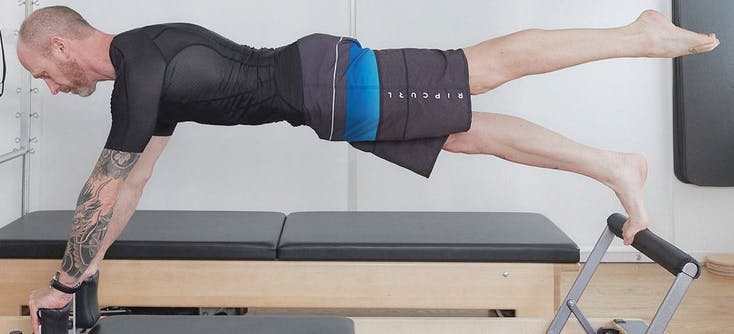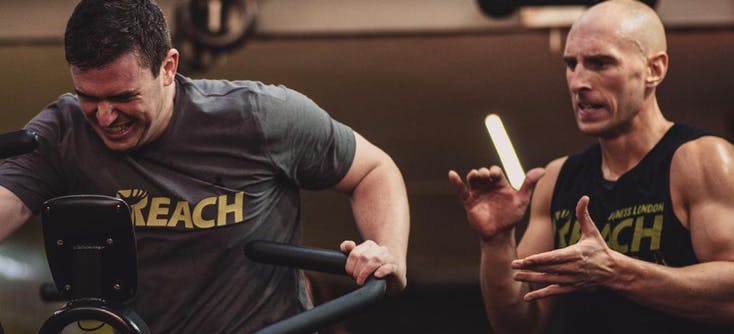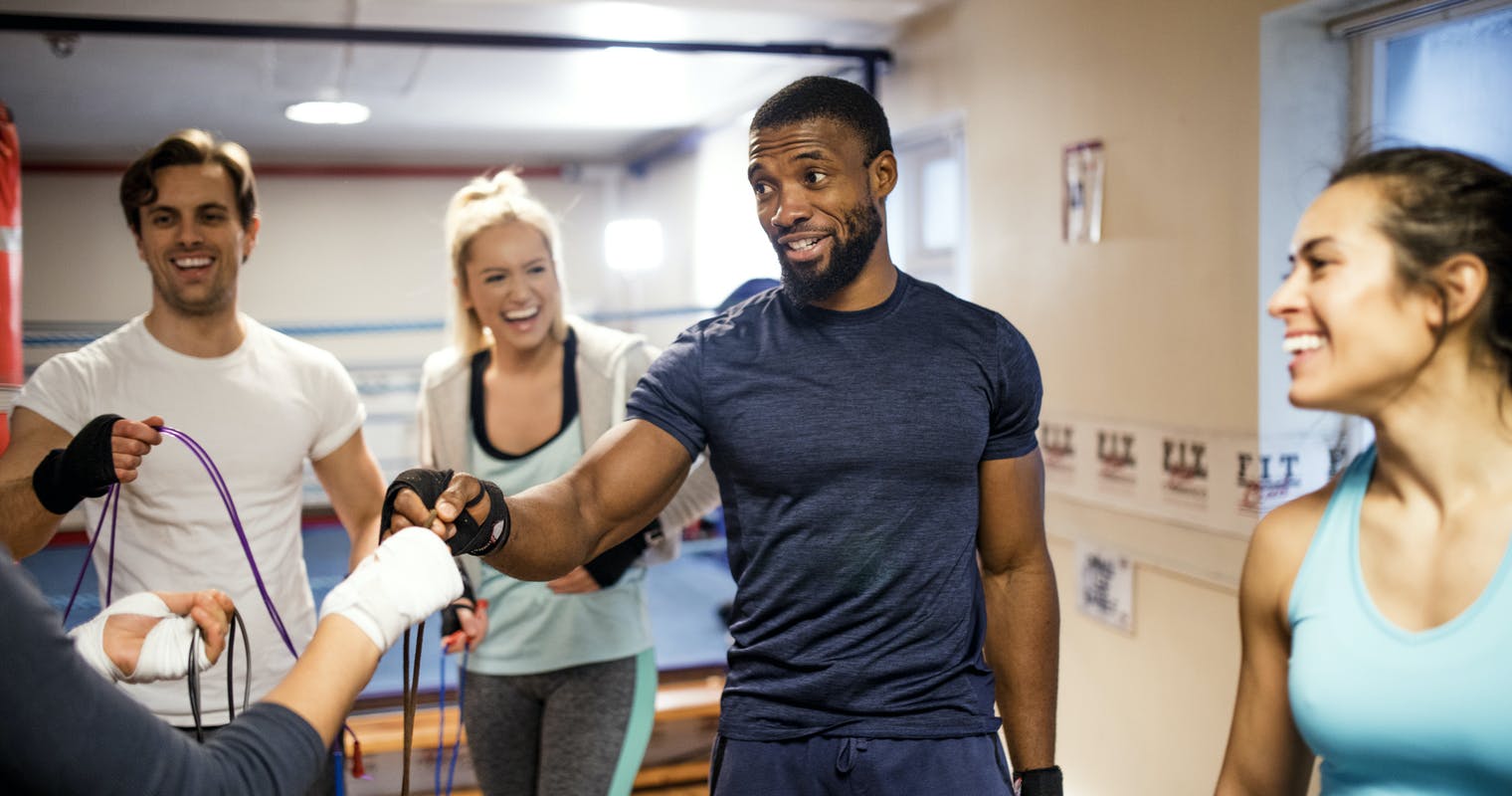If you've been going to Pilates classes for a while, you're well aware of the benefits it has. You've probably seen an improvement in posture, muscle tone, balance and joint mobility, as well as the mental benefits of relieving stress and tension. It's hardly surprising that you've now found yourself here after thinking about making Pilates your day-to-day. Taking the leap from student to instructor can seem daunting but it really doesn't have to be, especially if you are already researching how to become a Pilates instructor.

In this guide, we explain the steps you need to take and what you need to be aware of to embark on a new career as a Pilates instructor. From the basic skills and knowledge, you will learn to the qualifications you need, we're here to show you that becoming a Pilates instructor is a straightforward process.
Getting started as a Pilates instructor: requirements and the basic skills you need
Even before you begin thinking about certification or starting your Pilates business, you need to have a particular set of skills; skills you have acquired over a period of time that ensures you're suited to the role and to teach. Most of these skills can be learnt and adapted as you progress in your training program, but knowing what's expected of Pilates teachers before diving into a course is a good place to start for any budding instructors.
- Detailed knowledge of movements: A good working knowledge of Pilates is your first basic requirement before starting out on a career as a Pilates instructor, so a solid understanding of the discipline is required even for entry-level qualifications.
- Observation skills: Observing how your future clients perform movements and the corrections they will need in their form is at the core of what a Pilates instructor does. You need to be able to keep an eye out on a number of participants while leading your session.
- Communication: Communicating both verbally and non-verbally is an important skill to learn. You need to be able to clearly explain a movement or posture, and then if need be, correct or aid a client during the practice. Knowing when to step in to offer help is a key aspect of this. You don't want to leave someone struggling through a session, but at the same time, you don't want them to feel like they won't get through it without your constant intervention.
- Ability to motivate: At the centre of all of these skills is being able to keep clients motivated. For any clients who are new to Pilates, your ability to keep them motivated and keen to return is such an important part of retaining members. Of course, it will take time for them to get proficient at a new discipline and they won't be blind to that, but your teaching style and the rapport you build with clients that stems from motivational and supportive instruction is what will keep them coming back for more sessions.
Deciding what type of Pilates instructor you want to be
Knowing what approach you want to take as an instructor will help you decide on which course to take to earn your certificate to teach Pilates. It may be that you want to simply offer classic Pilates classes from your own Pilates studio, but for some, wanting to specialise in a specific area means taking specific courses to gain a better understanding in a specific area or style. Some areas that people may wish to focus on include:
Group sessions or one to one classes
A standard mat class can see anything from three to 30 students taking part, but equally, you can opt to teach one to one classes, or offer both. If you want to teach beginners, smaller classes are a better option for the student. You have more time to demonstrate and correct form, whereas larger classes are more suited for clients who are confident in the basics and require fewer corrections as they go.
Rehab and injury
Also known as clinical Pilates, this style of Pilates is popular for treating injuries and as such is typically taught one-to-one. Clients attending Pilates for post-injury rehabilitation will be looking for a rehab-qualified Pilates instructor rather than a general Pilates class.
Contemporary Pilates vs classical Pilates
This choice comes down to your own preferred style, which may well be informed by how you learnt Pilates in the first place, or how you were trained to lead Pilates classes. Classical Pilates is slow-paced with continual flowing movements, and it's the style of Pilates that Joseph Pilates himself developed. Contemporary Pilates is more fast-paced. It revolves around strength training with a focus on developing core strength and lean muscle.
Keep reading to find out how to choose the right Pilates certification program for you
How to become a certified Pilates instructor
Obtaining a proper Pilates instructor certification as a Nationally Recognised Pilates Teacher (NCPT) is a fundamental step in becoming a Pilates teacher and starting a Pilates studio business. First and foremost, proper training will give you the tools you need to successfully run classes and sessions for your clientele. Just having experience of taking Pilates and attending classes isn't enough on its own. Teaching is a skill that may come naturally to some but still needs honing before starting your own classes.
Secondly, certification is tangible proof to potential clients that you know how to safely and effectively run classes and sessions. It shows that you have been trained to lead classes and that you can attend to your clients during sessions with a certain degree of authority that you would otherwise be lacking.
How long does it take to be a Pilates instructor?
There are a number of reputable programs that you can join to earn your Pilates qualification. Which one you decide to take comes down to what your needs are. How much time you can dedicate to getting your certification completed is one aspect that needs to be taken into consideration. For most people, dedicating 100% of their time to a course with no other source of income just isn't practical or possible, so finding a course that offers part-time or continued learning is beneficial and useful. This doesn't mean you have to wait an unreasonable amount of time to get your certificate though. In a full-time program you can finish in just a few months, while part-time can take up to a year.
How much does a Pilates certification cost?
The amount that a Pilates instructor course cost depends on the course you choose. Don't immediately choose the cheapest option, but that doesn't mean you necessarily have to stretch to the most expensive either. The price of the course isn't as important as the course itself. Make sure that you're signing up for a course that suits your needs and your professional goals. A standard mat certification can cost around $100-$300, but a more comprehensive certification can take costs up to $3,000-$5,000. The NPCP (National Pilates Certification Program) exam, is just a one-off payment of $295.
Ensure you have the right insurance to teach Pilates classes
Becoming a full-time Pilates instructor requires you to make sure you are fully insured. Teaching a physical activity comes with its own set of risks, and making sure you are covered in case a client or member has an injury is crucial. If you're setting out to find a job in a studio rather than starting your own company, the Pilates studio you work for should have full insurance already that covers its employees as well. You want to be certain that your insurance covers the use of equipment, not just the studio space itself. In most cases, your insurance will cover:
- Damage to equipment
- Client injuries
- Loss of earnings
- Lawsuits and claims
Not every insurance package will offer the same deal for the same price, but you are typically looking at spending between $500-$1000 per year on your insurance. Using websites such as Trustpilot when researching who to buy a policy from is a good way to see how other consumers have found their experiences with a respective insurance firm.
How to market yourself as a pilates instructor
Getting certified will equip you with the tools you need in order to teach your classes and sessions, so your next task is to get people to attend them. Knowing how to market yourself as a pilates instructor can seem like a lot of work, but local marketing is an achievable way of targeting your target clientele in your area. You will have to put in the time to build a website, and developing a solid presence on social media is a vital part of any marketing strategy. However, once you have the foundations in place, spending some time each week on social media posts and content for your website is a relatively quick and simple process.

Now that you know how to become an instructor ask yourself
Is a career as a Pilates teacher the right path for me?
It may seem like a hard question to ask yourself, but your motivation for becoming a Pilates teacher is an important place to start. Instructing Pilates means dedicating a lot of time to helping others achieve their fitness goals while putting yours on the back-burner for a bit. While you're not going to have to stop practising Pilates yourself, if you're considering a Pilates instructor course in order to improve your own knowledge of Pilates rather than to become an instructor, then you should look into intensive Pilates courses rather than spend money learning to become an instructor.
Do I want to become a Pilates instructor as a hobby, part-time or a full-time career?
What you're really weighing up here is the amount of time you invest in getting your certificate to teach and instruct, as well as how much you pay for said certification. If you are interested in becoming a teacher as a hobby or side gig perhaps you will not need to take the comprehensive courses required for teachers who plan on making Pilates a career, but the option is there. If it's going to be a professional move, be it full-time or part-time, choosing the course that is going to give you the most full and complete training, as well as proper qualifications, should be what you set your sights on.
Where would be my ideal place to work be? A studio? Your home?
This is important to consider as different studios will require different things As a newly qualified instructor, teaching in a studio or already established facility can help you gain some more experience. If your goal is to open your own studio, learn from what other teachers and owners are doing while you build up your training, business skills, and determine what you want.
How much do Pilates instructors make?
When it comes down to it, finances play a large role in any career move. If you're going to invest time, effort, and capital into training and getting your certificate, you need to know how much you can then expect to make as a Pilates instructor.
Hfe.co.uk says that in the UK, instructors working on a freelance basis can expect to make between £20-£45 per hour. Outside of London, the rate is more likely to hover around the £20 per hour mark, whereas in London or other major cities, you can expect to earn more for your classes and sessions. According to bizinsure.com, in the USA, a fully-certified Pilates instructor is likely to earn up to approximately $68,910 annually.
In summary
Starting a new career is always an exciting prospect. Pursuing your passion in your professional life does take work and planning, however. Ensuring that you're earning the correct certifications to give yourself the best possible start is vital. Selecting a course that will give you the right foundations to teach the type of Pilates that most interests you, whether you want to work independently or apply for a position with an established Pilates studio business, as well as one that fits with your current schedule is the first step on your new career path.
Wondering how to get your Pilates business off the ground? Find out how to market your Pilates studio here, and get tips and advice from an established Pilates studio owner about growing your business here.
Frequently Asked Questions
How to become a pilates instructor?
There is no one-size-fits-all answer to this question, as the best way to become a Pilates instructor will vary depending on your goals and objectives. However, some general tips can help you get started on the right path:
- Determine why you want to become a Pilates instructor.
- Consider how much time and money you're willing to invest.
- Decide where you want to teach.
- Research different certification courses.
- Take the course and pass the NPCP exam to get certified to teach.
- Select a class that fits your schedule.
- Get started on your new career path!
How long does it take to become a pilates instructor?
Most certification courses take between 20 and 40 hours to complete. Some courses may be shorter or longer, depending on the program and the level of certification you're pursuing. After finishing your courses, take and pass the exam by the National Pilates Certification Program (NPCP) to get yourself certified.
How much does it cost to become a pilates instructor?
The cost of becoming a Pilates instructor can vary depending on the type of certification you're pursuing. Some courses may cost a few hundred dollars, while others may be a few thousand dollars. Research different programs and compare pricing before enrolling in a course.
How much do pilates instructors make?
Pilates instructors typically make $30-50 per hour. However, the pay can vary depending on experience, location, and other factors.
How to teach pilates?
To teach pilates properly, you should be welcoming to your students, set the atmosphere, and give clear and concise instructions are critical in any Pilates class. You should also be prepared to offer modifications and progressions to accommodate different fitness levels. Finally, ensure you are always aware of your students' form and safety.
What are the best insurance for pilates teachers?
Many different insurance companies offer coverage for Pilates instructors. Some of the best options include Progressive, Fitness Instructor Insurance, and United Health Care.









